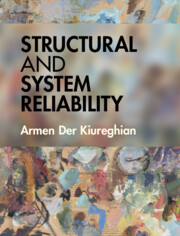Refine search
Actions for selected content:
36846 results in Cambridge Textbooks

Structural and System Reliability
-
- Published online:
- 13 January 2022
- Print publication:
- 13 January 2022
-
- Textbook
- Export citation

Energy Conversion Engineering
- Towards Low CO2 Power and Fuels
-
- Published online:
- 13 January 2022
- Print publication:
- 11 November 2021
-
- Textbook
- Export citation
4 - Modal Structure of State-Space Systems
-
- Book:
- Linear Multivariable Control Systems
- Published online:
- 02 June 2022
- Print publication:
- 13 January 2022, pp 167-200
-
- Chapter
- Export citation
16 - Deep Networks for Classification
- from Part III - Applications to Real-World Problems
-
- Book:
- High-Dimensional Data Analysis with Low-Dimensional Models
- Published online:
- 11 March 2022
- Print publication:
- 13 January 2022, pp 526-572
-
- Chapter
- Export citation
8 - Convex Optimization for Structured Signal Recovery
- from Part II - Computation for Large-Scale Problems
-
- Book:
- High-Dimensional Data Analysis with Low-Dimensional Models
- Published online:
- 11 March 2022
- Print publication:
- 13 January 2022, pp 305-364
-
- Chapter
- Export citation
1 - Introduction
-
- Book:
- Structural and System Reliability
- Published online:
- 13 January 2022
- Print publication:
- 13 January 2022, pp 1-10
-
- Chapter
- Export citation
Detailed Contents
-
- Book:
- Managerial Economics
- Published online:
- 09 February 2022
- Print publication:
- 13 January 2022, pp vii-xxi
-
- Chapter
- Export citation
9 - The Linear Multivariable Servomechanism
-
- Book:
- Linear Multivariable Control Systems
- Published online:
- 02 June 2022
- Print publication:
- 13 January 2022, pp 409-441
-
- Chapter
- Export citation
13 - Investment Analysis
- from Part IV - Strategy Analysis
-
- Book:
- Managerial Economics
- Published online:
- 09 February 2022
- Print publication:
- 13 January 2022, pp 617-668
-
- Chapter
- Export citation
Part I - Introduction
-
- Book:
- Managerial Economics
- Published online:
- 09 February 2022
- Print publication:
- 13 January 2022, pp 1-2
-
- Chapter
- Export citation
7 - Nonconvex Methods for Low-Dimensional Models
- from Part I - Principles of Low-Dimensional Models
-
- Book:
- High-Dimensional Data Analysis with Low-Dimensional Models
- Published online:
- 11 March 2022
- Print publication:
- 13 January 2022, pp 263-302
-
- Chapter
- Export citation
Part V - Government Policy
-
- Book:
- Managerial Economics
- Published online:
- 09 February 2022
- Print publication:
- 13 January 2022, pp 669-670
-
- Chapter
- Export citation
Preface
-
- Book:
- High-Dimensional Data Analysis with Low-Dimensional Models
- Published online:
- 11 March 2022
- Print publication:
- 13 January 2022, pp xix-xxvii
-
- Chapter
- Export citation
References
-
- Book:
- Linear Multivariable Control Systems
- Published online:
- 02 June 2022
- Print publication:
- 13 January 2022, pp 671-676
-
- Chapter
- Export citation
11 - Wideband Spectrum Sensing
- from Part III - Applications to Real-World Problems
-
- Book:
- High-Dimensional Data Analysis with Low-Dimensional Models
- Published online:
- 11 March 2022
- Print publication:
- 13 January 2022, pp 440-455
-
- Chapter
- Export citation
Index
-
- Book:
- High-Dimensional Data Analysis with Low-Dimensional Models
- Published online:
- 11 March 2022
- Print publication:
- 13 January 2022, pp 674-685
-
- Chapter
- Export citation
Acknowledgments
-
- Book:
- Structural and System Reliability
- Published online:
- 13 January 2022
- Print publication:
- 13 January 2022, pp xv-xvi
-
- Chapter
- Export citation
3 - Convex Methods for Sparse Signal Recovery
- from Part I - Principles of Low-Dimensional Models
-
- Book:
- High-Dimensional Data Analysis with Low-Dimensional Models
- Published online:
- 11 March 2022
- Print publication:
- 13 January 2022, pp 69-131
-
- Chapter
- Export citation
Part I - Principles of Low-Dimensional Models
-
- Book:
- High-Dimensional Data Analysis with Low-Dimensional Models
- Published online:
- 11 March 2022
- Print publication:
- 13 January 2022, pp 31-302
-
- Chapter
- Export citation
Part III - Production and Cost Analysis
-
- Book:
- Managerial Economics
- Published online:
- 09 February 2022
- Print publication:
- 13 January 2022, pp 267-268
-
- Chapter
- Export citation
